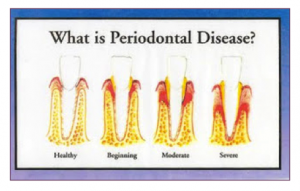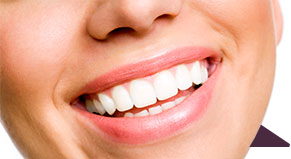Is Hydrogen Peroxide Bad for Your Teeth?
November 3rd, 2016
 Hydrogen peroxide is a medicine cabinet staple. Used for cleaning up scrapes and cuts, it also offers directions for oral use right on the label. But can it be harmful to your teeth?
Hydrogen peroxide is a medicine cabinet staple. Used for cleaning up scrapes and cuts, it also offers directions for oral use right on the label. But can it be harmful to your teeth?
What is Hydrogen Peroxide?
Hydrogen Peroxide is an oxidizing agent in clear liquid form. Chemically, all it is is water with an extra oxygen molecule. It acts as a mild antiseptic to prevent skin infections due to cuts and scrapes and can also be used to relieve minor mouth irritations and mucus. When applied to the affected area, the hydrogen peroxide releases oxygen and bubbles up, and the bubbles help clean and disinfect the area by lifting away dead skin cells.
How Do Dentists Use It?
Dentists first used hydrogen peroxide as a treatment for gum disease back in 1913, according to Registered Dental Hygienist Magazine (RDH). It is still used to fight gingivitis and periodontal disease.
Gingivitis is inflammation of the gums that can be a precursor to periodontitis. It occurs when the bacteria from plaque builds up, causing inflammation, and potentially leading to bleeds when brushing teeth. Rinsing with hydrogen peroxide under these circumstances kills the harmful bacteria and can prevent the inflammation from getting worse, so dentists may recommend it for certain patients.
Periodontitis occurs when gingivitis is left untreated, and the gums and bone pull away from the tooth, creating pockets that can become infected. Dentists use custom-fit prescription trays to deliver the hydrogen peroxide deep into the periodontal pockets and hold it there for more effective treatment of periodontal disease.
Hydrogen peroxide is also a whitening agent and is sometimes used by dentists to help with tooth whitening. The bottled hydrogen peroxide available in stores is generally 3% concentration, but products designed for dentists to use for tooth bleaching can contain up to 10% hydrogen peroxide.
Some over-the-counter whitening products like toothpaste, rinses, and whitening strips contain hydrogen peroxide as their bleaching agent. At home, it can also be combined with baking soda to make natural whitening toothpaste.
Can Hydrogen Peroxide Be Bad for Your Teeth?
Many dentists do not recommend regular use of hydrogen peroxide as a mouthwash or rinse. Regular use can cause irritation of the gums and can be too harsh for those with crowns, fillings, and dental implants.
Some dentists believe hydrogen peroxide can safely be used as an oral rinse if it is diluted with a mixture of water and Listerine. But because it can be so harsh on the gums and enamel, it should only be used if recommended by a dentist. There are other oral rinses available over the counter that contain hydrogen peroxide and may be less abrasive and therefore more suitable for regular use.
Is it Safe to Use at Home?
Hydrogen peroxide on its own should not be used for dental purposes at home unless directed by a dentist. If diluted in a solution of one-part hydrogen peroxide, one-part water, and one part Listerine, it is safe to use as a rinse and could be helpful for the treatment of gingivitis.
Consult a dentist to determine if such a solution is beneficial or if there are other treatments or rinses that would be safer. Hydrogen peroxide combined with baking soda can be used as a natural, at-home whitening toothpaste, but using correct proportions is key to ensuring it’s more helpful than harmful. At Water Tower Dental Care, we offer take-home teeth whitening trays that contain a safe yet effective amount of hydrogen peroxide-bleaching agent.
As always, when considering any at-home remedies, particularly for treating diseases like gingivitis and periodontitis, it’s important to consult a dentist to determine the safest, most effective form of treatment. It’s always safer to purchase ADA-approved products with hydrogen peroxide or receive professional treatments from your dentist. Making your own concoction could be more harmful than beneficial.
If you think you have gum disease or want to whiten your teeth, contact Water Tower Dental Care today! We can examine your pearly whites and put you on a path to effective treatment.

 Gum disease is no joke. Not only can it be hard to detect if you don’t know what to look for, but gum disease can also cause serious problems down the road. Don’t think you have it? Well,
Gum disease is no joke. Not only can it be hard to detect if you don’t know what to look for, but gum disease can also cause serious problems down the road. Don’t think you have it? Well,  Before Gum Disease Treatment Therapy[/caption]
Before Gum Disease Treatment Therapy[/caption] After Gum Disease Treatment Therapy[/caption]
After Gum Disease Treatment Therapy[/caption] While people usually focus on keeping their teeth pearly white, your gums should not be overlooked. Even if your teeth are as healthy as they can be, your gums may not be free from disease. As gum disease is usually painless, it often goes unnoticed. Gum disease, however, is treatable and the damage can fortunately be reversed. Learn more about gum disease and treatments at home to prevent your gums from looking like
While people usually focus on keeping their teeth pearly white, your gums should not be overlooked. Even if your teeth are as healthy as they can be, your gums may not be free from disease. As gum disease is usually painless, it often goes unnoticed. Gum disease, however, is treatable and the damage can fortunately be reversed. Learn more about gum disease and treatments at home to prevent your gums from looking like  When it comes to mouths, people typically care most about their teeth. But your gums are just as important as your pearly whites. Gums hold your teeth together, keep them protected from bacteria, can give you bad breath, and
When it comes to mouths, people typically care most about their teeth. But your gums are just as important as your pearly whites. Gums hold your teeth together, keep them protected from bacteria, can give you bad breath, and  There are many side effects to pregnancy. We all have heard of morning sickness or the late night cravings that some women can get. However, pregnancies can also bring another change in a woman’s body: a heightened risk of gingivitis.
There are many side effects to pregnancy. We all have heard of morning sickness or the late night cravings that some women can get. However, pregnancies can also bring another change in a woman’s body: a heightened risk of gingivitis. To keep a healthy smile, one must focus on the gums just as much as their teeth. Without proper care, gums can harbor many harmful types of bacteria that can result in gum disease. We already listed the best ways for
To keep a healthy smile, one must focus on the gums just as much as their teeth. Without proper care, gums can harbor many harmful types of bacteria that can result in gum disease. We already listed the best ways for 




 Website Powered by Sesame 24-7™
Website Powered by Sesame 24-7™